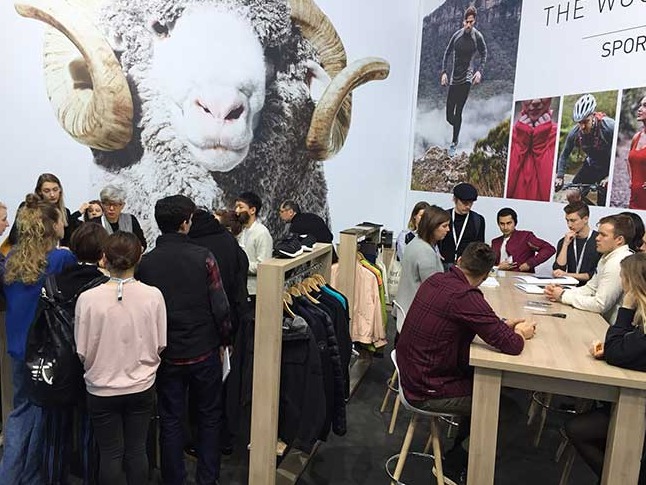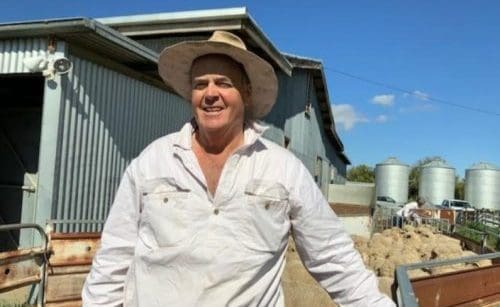
The Woolmark Company stand at the ISPO trade fair. How much should Australia be spending on wool marketing?
NEW South Wales wool grower David Taylor has proposed that COVID-19 could be a catalyst for a higher levy to raise Australia’s wool marketing spend and tell all the facets of the good wool story.
Explaining his motives behind a letter released to the media recently, the Trundle wool grower said he wanted to draw out some industry dialogue on wool marketing and industry structure without the politicking for which the industry is famous.
He said Charles Massey’s book ‘Breaking the Sheep’s Back’ should be a mandatory case study in every business school on how power, ego and politics can destroy an industry.
“Getting rational dialogue on marketing and structure is still a bit tricky in the wool industry and probably hasn’t been achieved since Sir William Gunn managed to talk the industry into chipping in for a marketing levy in the 1960s.
“This set the stage for the extraordinary success the industry enjoyed from the mid-1970s,” Dr Taylor said.
An excerpt of Dr Taylor’s letter was initially published in The Land, and has prompted a response from fellow NSW wool grower Jim Gordon. Sheep Central is publishing Dr Taylor’s full letter and Mr Gordon’s response.
Both growers argue for the end of wool politics and a focus on real issues, but Mr Gordon instead proposes a further dropping of the wool levy to 0.5pc within four years.
A marketing budget of $200 million would be a good start – Taylor

Trundle wool grower David Taylor.
Dear Sir,
The recent wool market collapse — the 50 percent decline from an Eastern Market Indicator from about 2000c/kg to about 900c/kg — despite the lowest wool production in 200 years, is conveniently blamed on the economic effects of the COVID-19 pandemic.
The fact that the cotton price has declined a modest 15pc from $A2.53 per kg to about $A2.15 over the same period, despite the highest world cotton stocks in the last five years — ~20m tonnes — raises some poignant questions about wool industry structure.
Is the harvesting of the heavy wool marketing and product development investment spend of the late 20th century finally wearing out? Is the wool industry caught up in the plethora of trade disputes surrounding Australia’s relationship with China?
Wool accounts for about one percent (cotton 40pc) of the world’s apparel textile trade and Australia produces about 80pc of that wool. Wool is an expensive fibre to produce. A hectare of prime western New South Wales native grassland developed for irrigated cotton will produce about 10 to 15 bales of cotton (1700–2550 kg). It takes 15ha of the same grassland to produce a bale of Merino wool.
Wool is also expensive to process. It must be shorn from the sheep, washed (scoured) and combed into tops ready for spinning into yarn. Cotton is ginned ready for spinning, a much simpler process, and most synthetic fibres are exuded instantly ready for spinning into yarn to be woven or knitted into cloth.
But wool is also nature’s miracle fibre. It is a living fibre that possesses many unique attributes, which are impossible for other apparel or textile fibres to emulate. It is the Rolls Royce of apparel fibres.
In the past, sophisticated apparel consumers recognised wool and the Australian wool industry’s flagship ‘Woolmark’ brand and willingly paid a premium of 8-12 times the price of cotton. This premium has now plunged to about 4:1, the lowest in twenty years. Premium pricing is everywhere, so why buy a $200,000 Porsche when a $20000 Hyundai will do about the same job? But premium pricing must be supported with sophisticated marketing.
A quiet revolution despite wool’s story imploding
The good news wool miracle fibre story does not stop there. A quiet revolution is under way in Australia’s sheep country. A collaboration between Merino sheep and regenerative agriculturalists has restored millions of hectares of Australia’s native grasslands, increasing their productivity and abundance and diversity of fauna and flora.
So why has this good news story so suddenly imploded? Perhaps COVID-19 is a catalyst rather than the cause.
Firstly China. China purchases about 80pc of Australia’s greasy wool production of about 340,000 tons. Wool has not been mentioned as being a target of any recent Chinese trade sanctions. Why would they? Wool is now a very small industry to Australia but a big industry to China. The Chinese make vastly more out of processing Australian wool (about $A15bn as wool tops and possibly 5 times that when sold as either yarn, cloth or garments) than does Australia out of selling greasy wool ($A3bn).
Why risk bringing wool processing back?
Why risk Australia wanting to bring wool processing back on shore? Yes, back on shore. Australia had state of the art on shore wool processing, much of it in regional areas, up until the collapse of the wool Reserve Price Scheme in the late 1980’s. The Reserve Price Scheme collapse was triggered, in no small measure by the wool industry reliance on two markets that closed within months of each other…. China, with Tiananmen Square, and Russia, with the fall of the Berlin Wall. The result was the eventual collapse of the Australia’s sheep flock from about 180 million sheep to today’s 70 million. It seems the law of fast forgetting is still alive and well.
Current wool marketing spend is not enough ….
Secondly, wool marketing support. Australian Wool Innovation is responsible for world wool promotion. AWI raises funds from a 1.5pc levy on Australian greasy wool sales. AWI has a marketing budget is about $A45m. To put this in perspective: the world cotton industry marketing spend is estimated at $US2bn; Harvey Norman with revenue similar to the Australian wool industry ($A3bn) spends about $180 million or about 6pc of sales; Woolworths $240 million and the current agricultural market darling, A2 Milk’s, marketing spend is about $A200 million or about 10pc of sales. If Sydney were AWI’s chosen target market segment, $45m is about $7.50 for each person. Not enough to achieve any impact …. in fact, a waste of money. However, AWI appears to do amazingly well with its very meagre budget.
A marketing budget of $200 million would be a good start
To be serious about defending a premium price strategy in a clearly defined world market segment of sophisticated apparel consumers — who can afford and appreciate what wool has to offer — a marketing budget of $A200 million would be a good starting point. Shocking …yes when it is wool producers who must foot the bill and China that receives the most benefit. But ask yourself, would you rather $1000 per bale with no deductions, or $2000–$3000 less a deduction of $200–$300 contributed to marketing? Coincidently, the $60m marketing budget the then Australian Wool Corporation raised from a 5pc levy on the sale of 4 million bales shorn from 180 million sheep prior to the collapse of the reserve price scheme in today’s dollars would be about $250m–$300m. Any wonder the wool brand logo was one of the best-recognized marketing symbols in the world after the Mercedes Benz three-point star and Coca-Cola.
David Taylor, B. Bus (Monash), B.Arts (Griffith), Master Rangeland Management (Queensland), PhD (UNE), Dip marketing, Cert. Agriculture (Yanco), Cert Sheep and Wool (NSW TAFE), ‘Myola’, Trundle. NSW.
Drop the levy and AWI’s budget to match the industry – Gordon

Young wool grower Jim Gordon.
Dear Sir,
Thank you Dr Taylor for taking the time to pen a very interesting article. If I may make a few comments.
Firstly, I quote you “Wool is also nature’s miracle fibre. It is a living fibre that possesses many unique attributes, which are impossible for other apparel or textile fibres to emulate. It is the Rolls Royce of apparel fibres”.
For this reason, in my opinion, we don’t need to spend money marketing the raw product. Like gold and iron ore, they sell themselves. If we take wool through to the garment, then we would have to spend heaps on marketing. The same as gold jewellery or steel products. You need to market the final product. The marketing of wool needs to be done by the brands and retailers, and they are infinitely better at that than a wool producer body.
However, if you are supplying a luxury product, it has to be 100 percent right. Non-mulesed and 100 percent comfort. At the moment, all the negative press on the turmoil of the Australian Merino industry is only allowing a perceived mediocre product to be available. There is no point in spending heaps on promotion on this type of product. As an industry, if we want to supply the top end, we must give them — the trade and welfare groups — what they want.
Your comments on the money being spent on promotion in other industries refer to expenditure on the final product. In my opinion, we need to be spending our levies on producing better products, meat and wool for the consumer, and on shearing schools.
Shrink AWI to match the industry
In my opinion, our peak body needs to be shrunk down to match the industry’s size or its production. We haven’t got 180 million sheep any more. Australian Wool Innovation’s budget should be in the vicinity of $10-$15 million in total from a 0.5pc levy. Hopefully we will get there eventually, with a levy vote of 1pc in next year’s WoolPoll, then in three years’ time 0.5pc. Once we get all the politics and self-interest out, we can then build an organisation with complete disclosure and transparency. Unless someone has a better way of doing it, I’m all ears.
No action needed on Chinese processing reliance
Secondly, you talk about the huge profits Chinese processors are making. This is a good thing, because they will keep coming back to the honey pot. On the other hand, the Chinese will readily process wool for the Australian wool producer, into tops, yarn, cloth or finished apparel a lot cheaper than we could if we were to try to bring processing back to Australia.
If onshore processing is the Australian wool producer’s preferred option, then they also can try to tap into the huge profit, if they can sell their finished article. Good luck. I am very happy to sell the raw product to the Chinese and they in turn make their profit.
Growers must get control of how levy is spent
Thirdly, you talk about funding Australian Wool Innovation. The problem with AWI is the culture, the old boy network and the resistance to change. Only at the last WoolPoll were the levy payers able to drop the levies from 2pc down to 1.5pc. I suspect the reason was levy payer frustration with AWI’s wastage. AWI runs an extremely good organisation, but that is quite easy when someone puts $100 million on the table each year that you don’t have to work for. However, it is just a well-run corporate entity with little connection or benefit to the levy payer.
Somehow the levy payer has to get back complete control on how much levy they pay and where that money is spent. Someone please help, Minister Littleproud.
Levy payers need direct control of their levies and our peak body needs to be a small outfit passing information — the truth from the trade and the welfare groups — to the growers. Then the growers with full control can decide what they do with that information.
If there is a need for a board, then it should be voluntary, with perhaps some travel concessions. We certainly don’t need a huge expensive head office and it certainly doesn’t need to be in the most expensive part of the most expensive city in Australia.
All levy payers would have a heart attack if they knew what the rent on the AWI head office is, locked in from 2015 to 2022. Seven years. I would love to see the ‘minutes’ detailing who signed off on the decision.
Finally, you talk about the wonderful work being done on regenerative agriculture. I agree; however, a lot of the country area that would benefit from regenerative agriculture is now running goats and Dorpers, not Merinos. There’s a question mark over this; they are great money makers, but is the bush suffering?
Jim Gordon, Young, NSW.

I am horrified at the suggestion of spending $200 million on more generic marketing for wool, so I must ask the question; How do you market a commodity?
After 20 years surely there very few retail brands who are not fully aware of merino and its technical attributes.
The market is changing. Consumers increasingly want to know more about the products they are buying, what they are made of, where they made and the conditions they are made under.
Wool was once a generic product, but it need not be any longer.
Let’s try a new approach. Let’s turn it into a product, and I do not mean manufacture a garment.
Growers who have ceased mulesing, are prepared to be identified and promoted, have their Merino farming enterprise verified to a standard and to supply through a transparent supply chain are in effect selling a product with identifiable attributes.
Add to that the Merino wool produced by growers who have ceased mulesing and you have not just a product but one that is in demand from the new generation of consumers and the retail brands that supply them.
Do I have to remind everyone that New Zealand is already doing it with Australian wool? What are we waiting for?
Peter Vandeleur http://www.newmerino.com.au
Rather than growers arguing about AWI and the levy, the best thing the industry could do is to take heed of Peter Vandeleur. The best investment Australian wool growers could make is to listen carefully to our customers and supply what they want: certified non-mulesed wool. That’s the investment that will give the greatest return once this COVID-19 event has passed. Forget AWI, they have already written themselves out of the game by ignoring the urgency of informing growers they must cease mulesing.
Great to see some passionate debate from David and Jim, two great Aussie wool growers.
It is important we look at how much benefit has been accrued by AWI spending $700 million of wool tax over the past 10 years, the majority of this on “wool marketing”.
The fact that AWI abandoned the brilliant HRH Campaign for wool — engaging 200 retailers — and went back to Gold Woolmark/champagne/caviar/business class airfares for directors, says it all. It failed in the 50’s and 60’s, so why would it work again?
The debate clearly for all thinking wool growers is to the future of the levy. Has it worked? Could it ever work? Would be growers be better off with 1.5 percent of their gross proceeds in the bank? Could we survive without AWI?
Chick, 700 million. It’s worse than a bad government. At least one can get rid of a bad government.
I don’t care what the levy is, as long as the levy payer can have complete control on setting that levy and how the money is spent. I am sick of the waste.
I was invited to a function put on by Nanshan and AWI, down on the Hawkesbury – a golf weekend. The opulence was embarrassing. The venue was a beautiful place but if you want to ask people there, let them pay for it, not the poor levy payer.
I go down to Bendigo show in July 2019 and in the main thoroughfare, a huge presence of AWI — promotion. I am greeted by AWI staff that question my attitude to AWI. I thought it was a bit rich when I am helping financing the whole fiasco.
I suspect I am the most hated person in AWI; however, I wish the AWI staff would walk a mile in my shoes. I wish they had a compulsory levy taken out of their gross income and spent on stuff they disagreed with.
On the wool levy rate, it is not the percentage, but how effective it is being spent that needs consideration.
Wool has about 1pc or less of textile market. If it disappeared, on a population basis, not many would notice. With such a small market share, wool has to be at the elite, highest value end of market. The idea of putting every one in China in a pair of woollen socks could be done and wool price would be worth next to nothing, so that is not answer. Think high-end.
Now Marketing 101, give the consumer the product they want and give it better than your opposition.
Now this is where AWI has a role to play. Have they gone out and found this answer?
Well, if they have, it is poorly communicated to current producers. If they haven’t, it is time to move aside and put someone or an organisation in charge that does.
Simply, if I, as a rural producer, can find what the consumer wants, what are the receivers of levy money doing?
Now the current drop in wool price is no surprise as a consequence of the pandemic.
The big thing will be will wool be positioned to take advantage when retail sales overall return?
I see much will depend on having the right stock available at the high price point level.
There is no reason why wool can’t have a future, but our wool levy input will need to be effectively spent on products that consumers want.